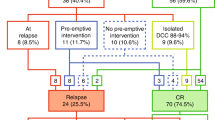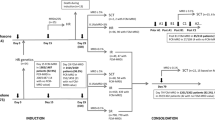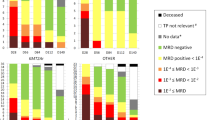Abstract
Despite the favorable prognosis of patients with acute myeloid leukemia (AML) with t(8;21)(q22;q22) translocation, relapses still occur in about 30% of the cases but no initial factors can strongly predict the risk of relapse. Several recent studies suggest that monitoring minimal residual disease (MRD) may identify patients at risk of relapse. We prospectively monitored AML1–ETO rearrangement by real-time quantitative PCR (RQ-PCR) in 21 patients uniformly treated in our center. Blood (PB) and bone marrow (BM) samples were collected during and after therapy. At diagnosis, levels of AML1–ETO transcript showed large variations and there was a trend for a higher relapse rate in patients with high pretreatment expression levels (P=0.065). After induction therapy, absolute transcript levels (below 10−3, compared to Kasumi cell line), or a greater than 3 log decrease by comparison to diagnosis levels, were significant predictors of the absence of relapse (P=0.02 and P=0.02, respectively). MRD levels after consolidation therapy were also significant indicators of relapse (P=10−5). Comparison of BM and PB samples showed similar sensitivity for detecting AML1–ETO transcript. In conclusion, RQ-PCR appears to be an early predictive factor of the relapse risk in AML with t(8;21). PB samples can be used adequately to evaluate the level of MRD by this technique.
This is a preview of subscription content, access via your institution
Access options
Subscribe to this journal
Receive 12 print issues and online access
$259.00 per year
only $21.58 per issue
Buy this article
- Purchase on Springer Link
- Instant access to full article PDF
Prices may be subject to local taxes which are calculated during checkout




Similar content being viewed by others
References
Erickson P, Gao J, Chang KS, Look T, Whisenant E, Raimondi S et al. Identification of breakpoints in t(8;21) acute myelogenous leukemia and isolation of a fusion transcript, AML1/ETO, with similarity to Drosophila segmentation gene, runt. Blood 1992; 80: 1825–1831.
Chang KS, Fan YH, Stass SA, Estey EH, Wang G, Trujillo JM et al. Expression of AML1–ETO fusion transcripts and detection of minimal residual disease in t(8;21)-positive acute myeloid leukemia. Oncogene 1993; 8: 983–988.
Grimwade D, Walker H, Oliver F, Wheatley K, Harrison C, Harrison G et al. The importance of diagnostic cytogenetics on outcome in AML: analysis of 1,612 patients entered into the MRC AML 10 trial. The Medical Research Council Adult and Children's Leukaemia Working Parties. Blood 1998; 92: 2322–2333.
Byrd JC, Dodge RK, Carroll A, Baer MR, Edwards C, Stamberg J et al. Patients with t(8;21)(q22;q22) and acute myeloid leukemia have superior failure-free and overall survival when repetitive cycles of high-dose cytarabine are administered. J Clin Oncol 1999; 17: 3767–3775.
Tallman MS, Hakimian D, Shaw JM, Lissner GS, Russell EJ, Variakojis D . Granulocytic sarcoma is associated with the 8;21 translocation in acute myeloid leukemia. J Clin Oncol 1993; 11: 690–697.
Billstrom R, Johansson B, Fioretos T, Garwicz S, Malm C, Zettervall O et al. Poor survival in t(8;21) (q22;q22)-associated acute myeloid leukaemia with leukocytosis. Eur J Haematol 1997; 59: 47–52.
Schoch C, Haase D, Haferlach T, Gudat H, Buchner T, Freund M et al. Fifty-one patients with acute myeloid leukemia and translocation t(8;21)(q22;q22): an additional deletion in 9q is an adverse prognostic factor. Leukemia 1996; 10: 1288–1295.
Byrd JC, Weiss RB, Arthur DC, Lawrence D, Baer MR, Davey F et al. Extramedullary leukemia adversely affects hematologic complete remission rate and overall survival in patients with t(8;21)(q22;q22): results from Cancer and Leukemia Group B 8461. J Clin Oncol 1997; 15: 466–475.
Nguyen S, Leblanc T, Fenaux P, Witz F, Blaise D, Pigneux A et al. A white blood cell index as the main prognostic factor in t(8;21) acute myeloid leukemia (AML): a survey of 161 cases from the French AML Intergroup. Blood 2002; 99: 3517–3523.
Morschhauser F, Cayuela JM, Martini S, Baruchel A, Rousselot P, Socie G et al. Evaluation of minimal residual disease using reverse-transcription polymerase chain reaction in t(8;21) acute myeloid leukemia: a multicenter study of 51 patients. J Clin Oncol 2000; 18: 788–794.
Marcucci G, Livak KJ, Bi W, Strout MP, Bloomfield CD, Caligiuri MA . Detection of minimal residual disease in patients with AML1/ETO-associated acute myeloid leukemia using a novel quantitative reverse transcription polymerase chain reaction assay. Leukemia 1998; 12: 1482–1489.
Tobal K, Yin JA . Monitoring of minimal residual disease by quantitative reverse transcriptase-polymerase chain reaction for AML1–MTG8 transcripts in AML-M2 with t(8;21). Blood 1996; 88: 3704–3709.
Wattjes MP, Krauter J, Nagel S, Heidenreich O, Ganser A, Heil G . Comparison of nested competitive RT-PCR and real-time RT-PCR for the detection and quantification of AML1/MTG8 fusion transcripts in t(8;21) positive acute myelogenous leukemia. Leukemia 2000; 14: 329–335.
Schnittger S, Weisser M, Schoch C, Hiddemann W, Haferlach T, Kern W . New score predicting for prognosis in PML-RARA+, AML1–ETO+, or CBFBMYH11+ acute myeloid leukemia based on quantification of fusion transcripts. Blood 2003; 102: 2746–2755.
Castaigne S, Chevret S, Archimbaud E, Fenaux P, Bordessoule D, Tilly H et al. Randomized comparison of double induction and timed-sequential induction to a ‘3+7’ induction in adults with acute myeloid leukemia (AML). Long-term analysis of the Acute Leukemia French Association (ALFA) 9000 study. Blood 2004; 104: 2467–2474.
Asou H, Tashiro S, Hamamoto K, Otsuji A, Kita K, Kamada N . Establishment of a human acute myeloid leukemia cell line (Kasumi-1) with 8;21 chromosome translocation. Blood 1991; 77: 2031–2036.
Van Dongen JJ, Macintyre EA, Gabert JA, Delabesse E, Rossi V, Saglio G et al. Standardized RT-PCR analysis of fusion gene transcripts from chromosome aberrations in acute myeloid leukemia for detection of minimal residual disease. Report of the BIOMED-1 Concerted Action: investigation of minimal residual disease in acute leukemia. Leukemia 1999; 13: 1901–1928.
Gabert J, Beillard E, van der Velden VH, Bi W, Grimwade D, Pallisgaard N et al. Standardization and quality control studies of ‘real-time’ quantitative reverse transcriptase polymerase chain reaction of fusion gene transcripts for residual disease detection in leukemia – a Europe Against Cancer program. Leukemia 2003; 17: 2318–2357.
Tobal K, Moore H, Macheta M, Yin JA . Monitoring minimal residual disease and predicting relapse in APL by quantitating PML-RARalpha transcripts with a sensitive competitive RT-PCR method. Leukemia 2001; 15: 1060–1065.
van Dongen JJ, Seriu T, Panzer-Grumayer ER, Biondi A, Pongers-Willemse MJ, Corral L et al. Prognostic value of minimal residual disease in acute lymphoblastic leukaemia in childhood. Lancet 1998; 352: 1731–1738.
Nucifora G, Larson RA, Rowley JD . Persistence of the 8;21 translocation in patients with acute myeloid leukemia type M2 in long-term remission. Blood 1993; 82: 712–715.
Satake N, Maseki N, Kozu T, Sakashita A, Kobayashi H, Sakurai M et al. Disappearance of AML1–MTG8(ETO) fusion transcript in acute myeloid leukaemia patients with t(8;21) in long-term remission. Br J Haematol 1995; 91: 892–898.
Miyamoto T, Weissman IL, Akashi K . AML1/ETO-expressing nonleukemic stem cells in acute myelogenous leukemia with 8;21 chromosomal translocation. Proc Natl Acad Sci USA 2000; 97: 7521–7526.
Jurlander J, Caligiuri MA, Ruutu T, Baer MR, Strout MP, Oberkircher AR et al. Persistence of the AML1/ETO fusion transcript in patients treated with allogeneic bone marrow transplantation for t(8;21) leukemia. Blood 1996; 88: 2183–2191.
Krauter J, Gorlich K, Ottmann O, Lubbert M, Dohner H, Heit W et al. Prognostic value of minimal residual disease quantification by real-time reverse transcriptase polymerase chain reaction in patients with core binding factor leukemias. J Clin Oncol 2003; 21: 4413–4422.
Marcucci G, Caligiuri MA, Dohner H, Archer KJ, Schlenk RF, Dohner K et al. Quantification of CBFbeta/MYH11 fusion transcript by real time RT-PCR in patients with INV(16) acute myeloid leukemia. Leukemia 2001; 15: 1072–1080.
Viehmann S, Teigler-Schlegel A, Bruch J, Langebrake C, Reinhardt D, Harbott J . Monitoring of minimal residual disease (MRD) by real-time quantitative reverse transcription PCR (RQ-RT-PCR) in childhood acute myeloid leukemia with AML1/ETO rearrangement. Leukemia 2003; 17: 1130–1136.
Biondi A, Valsecchi MG, Seriu T, D’Aniello E, Willemse MJ, Fasching K et al. Molecular detection of minimal residual disease is a strong predictive factor of relapse in childhood B-lineage acute lymphoblastic leukemia with medium risk features. A case control study of the International BFM study group. Leukemia 2000; 14: 1939–1943.
Miyamoto T, Nagafuji K, Harada M, Niho Y . Significance of quantitative analysis of AML1/ETO transcripts in peripheral blood stem cells from t(8;21) acute myelogenous leukemia. Leuk Lymphoma 1997; 25: 69–75.
Acknowledgements
This work was supported by the Fondation de France (comité leucémie) and by the CHRU of Lille (PHRC 1997).
Author information
Authors and Affiliations
Corresponding author
Rights and permissions
About this article
Cite this article
Leroy, H., de Botton, S., Grardel-Duflos, N. et al. Prognostic value of real-time quantitative PCR (RQ-PCR) in AML with t(8;21). Leukemia 19, 367–372 (2005). https://doi.org/10.1038/sj.leu.2403627
Received:
Accepted:
Published:
Issue Date:
DOI: https://doi.org/10.1038/sj.leu.2403627
This article is cited by
-
Prognostic and therapeutic implications of measurable residual disease in acute myeloid leukemia
Journal of Hematology & Oncology (2021)
-
Clinical significance of CD34+CD117dim/CD34+CD117bri myeloblast-associated gene expression in t(8;21) acute myeloid leukemia
Frontiers of Medicine (2021)
-
Response kinetics and factors predicting survival in core-binding factor leukemia
Leukemia (2018)
-
The dynamics of RUNX1-RUNX1T1 transcript levels after allogeneic hematopoietic stem cell transplantation predict relapse in patients with t(8;21) acute myeloid leukemia
Journal of Hematology & Oncology (2017)
-
Minimal Residual Disease in Acute Myeloid Leukemia
Current Treatment Options in Oncology (2017)



